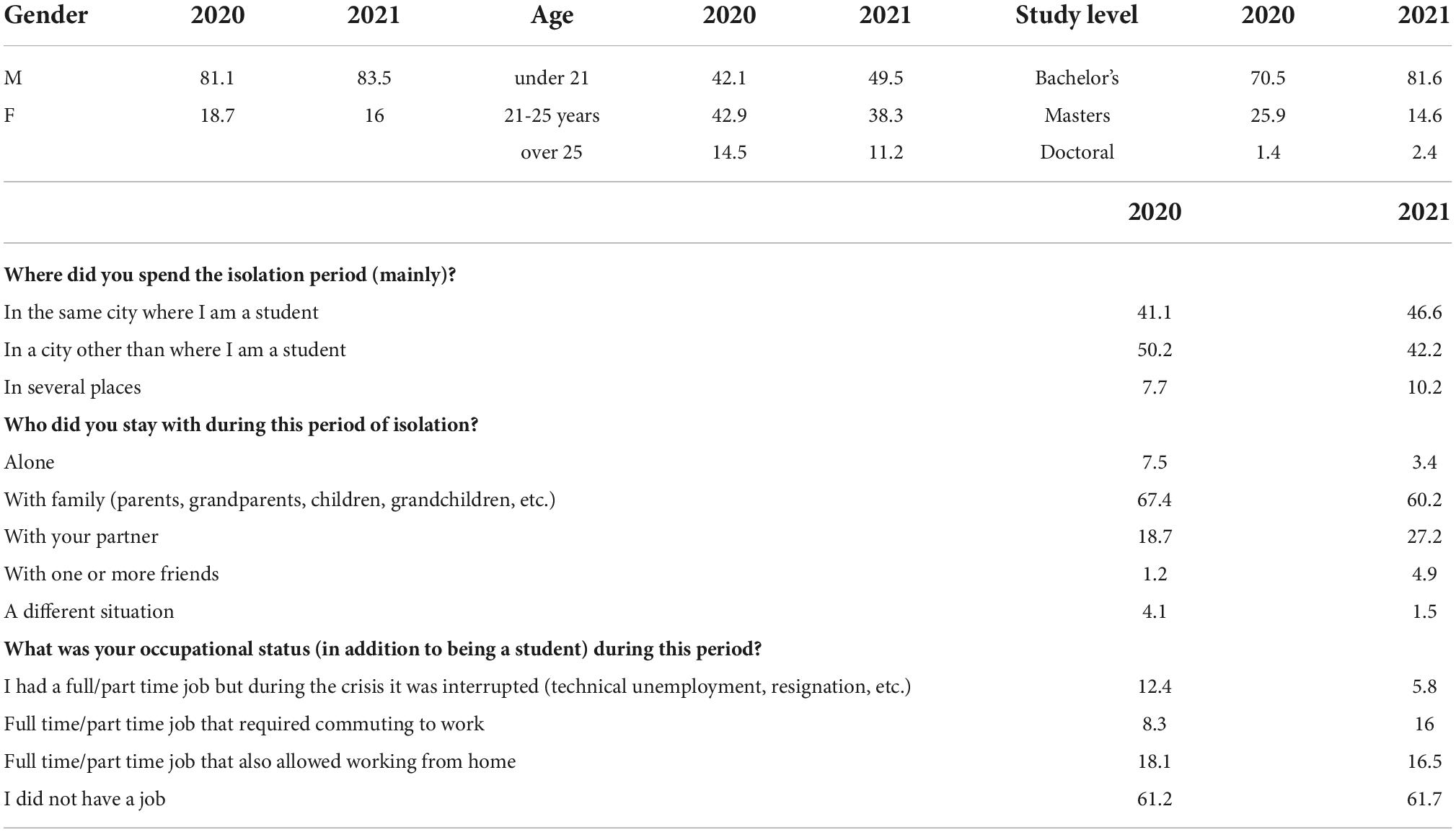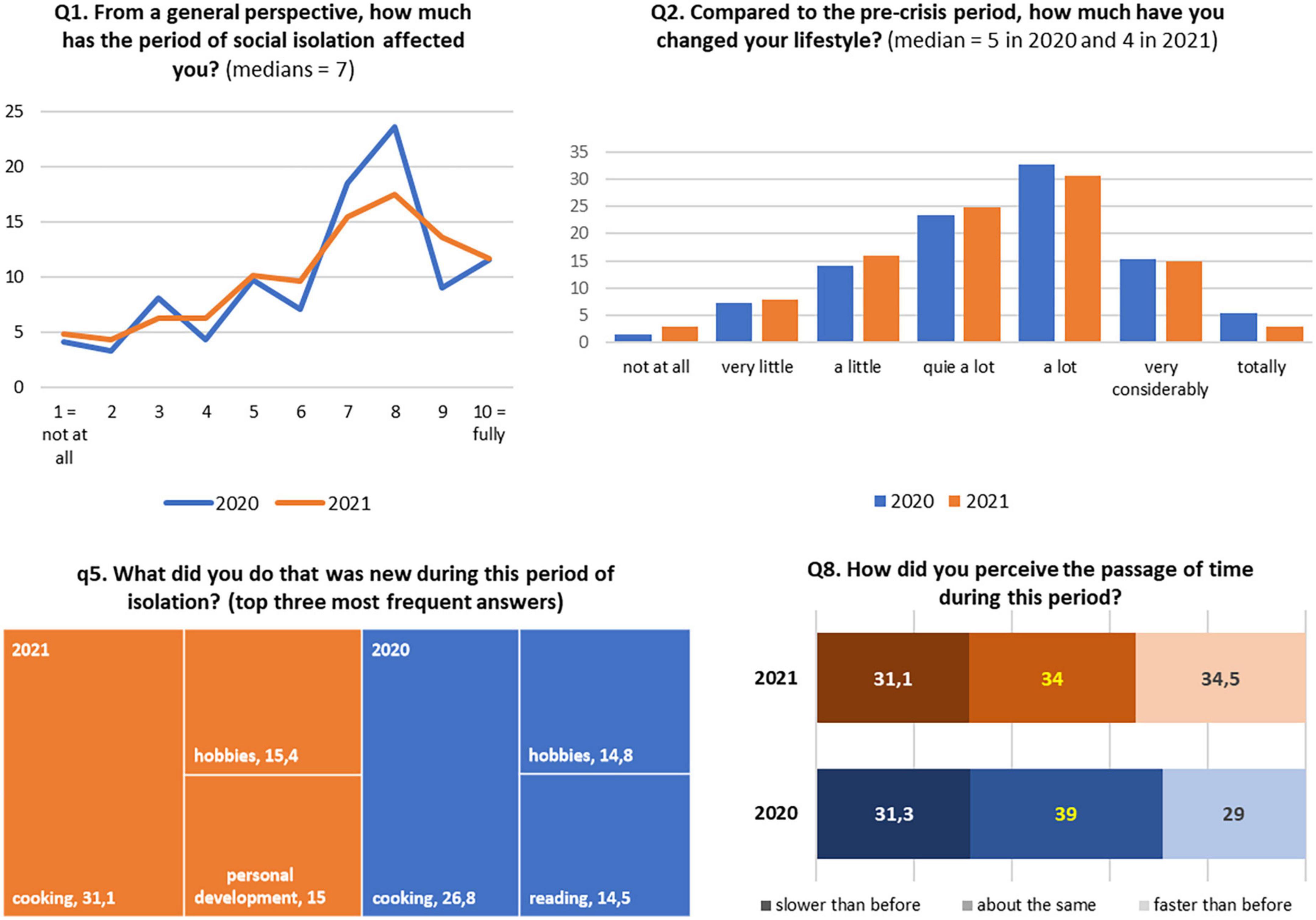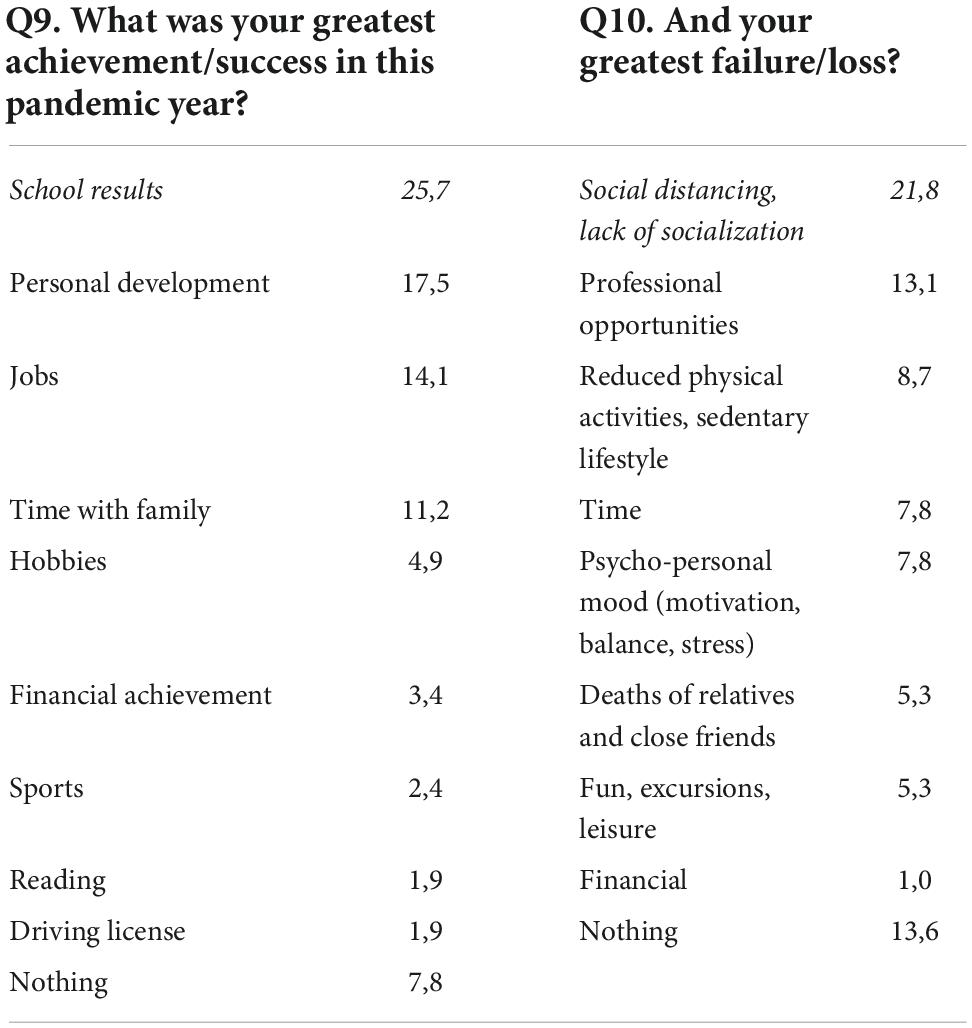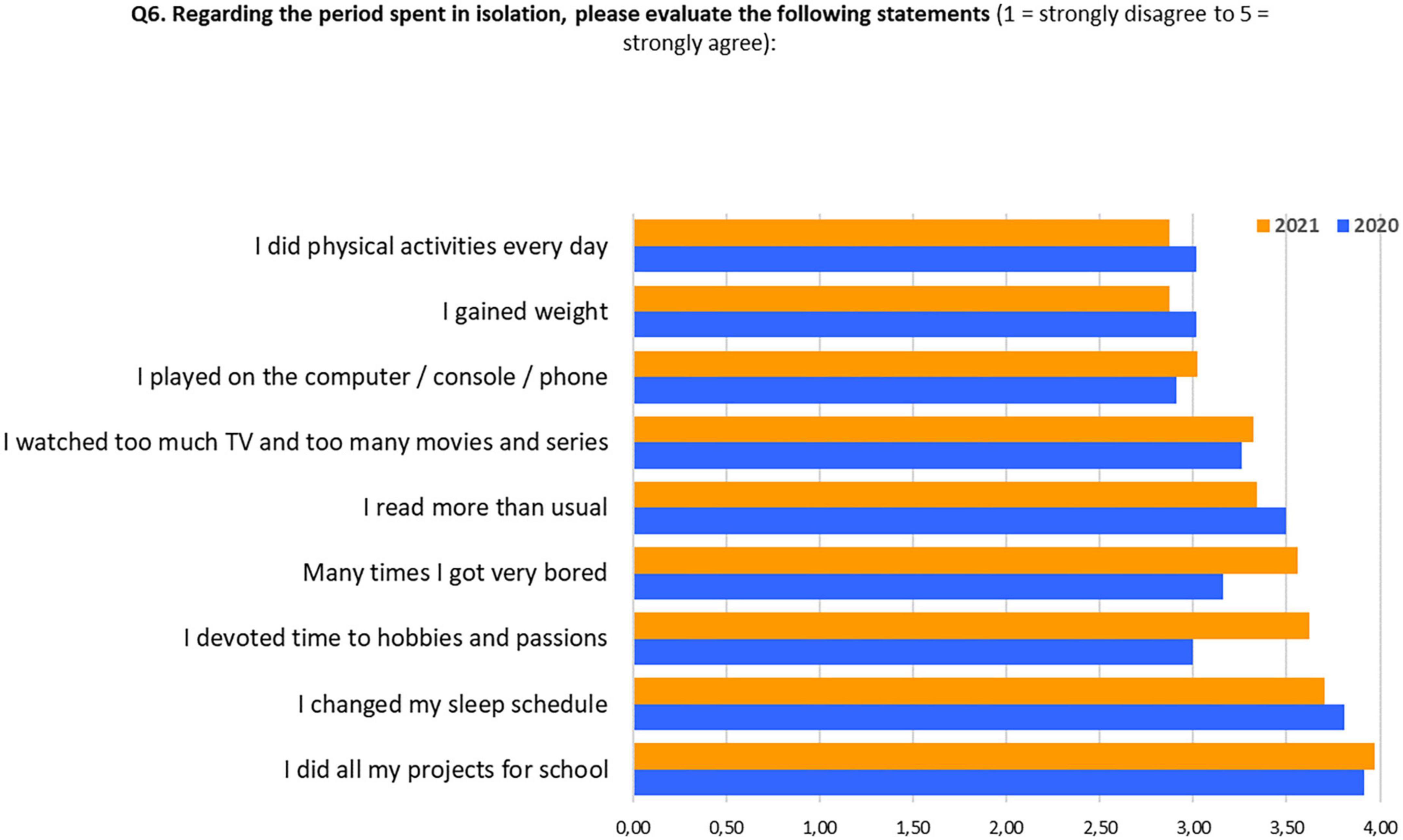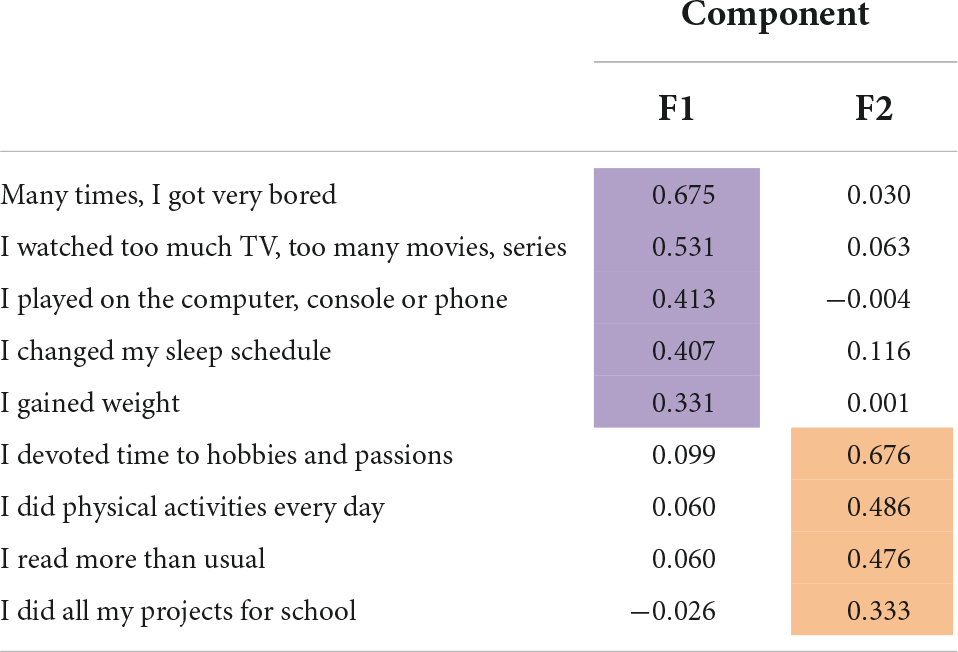- 1Department of Sociology, West University of Timişoara, Timişoara, Romania
- 2Department of Teacher Training, West University of Timişoara, Timişoara, Romania
We have already experienced almost two years of COVID-19 pandemic related problems, stress and negative feelings. All over the world, various restrictions have been imposed to reduce the spread of the virus. A particular social category directly affected by the COVID-19 restrictions is that of students. In Romania, classes have been held online from March 2020 until April 2022 for a large part of the higher education system. How have students been affected by these semesters of online classes? This paper sets out to answer this research question on the basis of two sociological surveys, applied online in May 2020 (N = 518) and in May 2021 (N = 206). Its main finding is that there are two different patterns students employ in order to cope with the limitations imposed by the pandemic restrictions: the badger approach, in which they take refuge in leisure activities, and the beaver approach, involving more dynamic and sustainable behaviors.
Introduction
The online teaching methods made necessary by pandemic restrictions represent a challenge for educational systems all over the world. According to UNESCO figures, after the first two months of the pandemic crisis (April 2020) the educational institutions of 186 countries were closed, affecting 74% of all enrolled learners (Di Pietro et al., 2020). Pupils, students, teachers, administrative staff, and parents had to swiftly improve their digital literacy in order to achieve the level of technology needed to keep the whole system alive (Ali, 2020; Marek et al., 2021). This was complicated for all involved, but to a considerable extent it is working. We are currently about to begin our fourth semester in this pandemic context, and it is time to draw some conclusions and lessons from experience to date regarding online and hybrid teaching.
During this period of over 18 months of pandemic restrictions numerous articles and research studies have appeared on a variety of topics related to online classes and student lifestyles. This is an ongoing phenomenon and our understanding of it needs to keep pace with it. For sociologists, despite all the negative consequences of the pandemic, it represents a valuable opportunity to observe and analyze a natural social experiment. A simple Google Scholar search for “the impact of COVID-19 in education” returns 950 million results (in September 2022), showing that we already have an enormous amount of data and recommendations on this topic that can be of use to any educator anywhere in the world. At a first glance, we can distinguish three main topics in this thematic area: (i) students’ health issues, (ii) didactic processes and (iii) students’ lifestyles (Burgess and Sievertsen, 2020; Di Pietro et al., 2020). Of course, these are interrelated, with all the aspects investigated having been generated by the same COVID-19 pandemic context. Many of these articles are based on a range of quantitative or qualitative filed research, others on metanalyses or simply on theoretical interpretations, but all of them represent valuable contributions to the subject of higher education in the pandemic context and have appeared during this specific period (Araújo et al., 2020; Bran and Grosseck, 2020; Gonçalves et al., 2020; Mishra et al., 2020; Cairns et al., 2021; Khan et al., 2021; Stevanovic et al., 2021).
Many of these studies are chiefly concerned with students’ psychological well-being. In the pandemic context, with numerous sources of stress and worry, mental equilibrium has been seriously affected, even in the case of people who are young and strong (Machado et al., 2020; Son et al., 2020; Teixeira et al., 2021). COVID-19 stress is closely related to meaning in life and to life satisfaction, and both of these factors are directly influenced by basic hope, the assumption of a positive social context, illustrated by altruism and pro-social behaviors (Trzebiński et al., 2020). Mental health is also directly related to social networks, and the physical isolation caused by COVID-19 restrictions has generated significantly increased stress, anxiety, loneliness and depressive symptoms (Elmer et al., 2020; Yang et al., 2021). It is clear that the virtual social network is not enough to satisfy human needs, and that direct interaction in person with real people from one’s personal network has taken on an increased support function during this crisis. Excessive time (over eight hours a day) spent in front of electronic screens, and low levels of outdoor activities (below two hours a day), are both directly associated with a high level of psychological impact of the COVID-19 effect on students (Browning et al., 2021). Although some optimistic researchers have endeavored to promote the advantages of an appropriate utilization of social media for “the new era of social learning” (Sobaih et al., 2020) or to find a “panacea for the crisis” (Dhawan, 2020), we need to distinguish between communication as exchange of content (which has been ultra-concentrated in this period) and communication as a means of interaction with alter (which has been ultra-limited). And along with the impact on the student population, the phenomenon of COVID-19 stress is also a present reality for teaching staff, who have had to deal with the risks brought by the pandemic, with the shift to online teaching, and with all their other personal concerns (Obrad, 2020).
The didactic process was also directly impacted by the unexpected (from one day to the next) shift to online teaching. Higher education was probably, all over the world, better prepared for this move than schools at lower levels, but problems were not completely avoided - and the didactic quality of the learning experience remains, after all, of paramount importance (Popa et al., 2020). One of the largest European surveys (N = 4859 teachers and educators), conducted by School Education Gateway (2020) and applied in April-May 2020, found that the positive dimensions of online learning were innovation (i.e., freedom to experiment with different styles of teaching) = 38.5%, flexibility = 33.5%, and a wide range of tools = 30.8%, while the negative aspects were pupils’ limited access to technology (49.2%), increased workload and stress working from home (43.3%) and keeping all pupils motivated and engaged (42.7%). In Romania, a recent study of this subject has identified three problems with online classes: technical issues, teachers’ lack of the necessary skills (technical, digital, and the ability to adapt their teaching style to the online environment), and the absence of student-teacher and student-student social interaction (Coman et al., 2020). Even though online interactions are not the same as when one is in a face-to-face situation, participation in classes with or without the use of a webcam represents another sensitive issue. The opportunity to see one’s classmates on screen is something less than seeing them in person but is definitely more than just seeing photographs of them. Despite this, almost half the students in a recent study were found to prefer not to turn on their cameras, if this was permitted, due to a fear of being exposed, embarrassment, and shyness (Gherheş et al., 2021). And this is just a minor aspect of online education. In our highly digitalized global world, the potential for the exchange of knowhow and good practice represents a very great opportunity, including for the upgrading of teaching techniques for online learning in the context of the COVID-19 pandemic (Marinoni et al., 2020).
Although the change in student lifestyle during the COVID-19 pandemic may be regarded as largely a consequence of online teaching, it is probably the most important dimension of the entire process (Bolumole, 2020; Goncalves et al., 2021). Despite their high level of digital literacy and access to IT infrastructure, on the one hand, and also despite the young, healthy profile of the student population, their lifestyles, as adapted by them to the constraints of the pandemic, have a direct impact on their educational performance and also on their health. Students’ coping with stress during the COVID-19 pandemic restrictions was represented by acceptance, planning, and seeking emotional support. All these were directly influenced by age, gender, and place of residence (Babicka-Wirkus et al., 2021). There is a clear distinction between the issues raised in highly digitalized countries that had full access to digital resources before the COVID-19 pandemic crisis, and in which we can talk about an over-saturation of spending time in front of screens, and those in which the process of digitalization is still under development and the issues discussed are related more to benefits than to problems. Country by country, the institutional response the educational system needs to adopt during these pandemic times is different, and, more importantly, the resources available are different too (Schleicher, 2020). Behind these analyses and recommendations, students are the same all over the world, and an excess of online life, in combination with a lack of social interaction, in fact generates the same kinds of problems. An improvement in our ability to resolve these issues will improve the social resilience of the contemporary educational system.
Materials and methods
The research question we used as our starting point was the following: how are students being affected by the move to online classes as a result of the constraints imposed by the pandemic? In order to discover the answer, two online sociological surveys were conducted on the student population. The first wave was applied in the last three days of the national lockdown in Romania, on 12-15 May 2020, and 518 responses were collected. The second wave was applied one year later, in May 2021, with 206 responses being collected. The two lots of subjects are availability samples and do not allow the generalization of the results. However, the collection of data even during the national lockdown period, i.e., one year later, makes them epistemologically relevant. Both surveys employed almost the same questionnaire, with eight items being identical. In the second wave, one question was eliminated (Q9. If such a situation of social isolation were to be repeated, what would you do differently?) and two new questions were added (Q9. What was your greatest achievement/success in this pandemic year? and Q10. But what was the most serious failure/loss?). The minor differences between the two questionnaires were determined by the change of the social context from the moment of application (the restrictions during the emergency state at the beginning of the pandemic being much more severe than those during the alert state, when the second study was conducted). The on-line questionnaire was built in Google Forms and promoted on the social media students’ groups of a number of universities in Romania, located in different cities (Timişoara, Bucureşti, Cluj-Napoca, Iaşi, Oradea), as well as on the groups of the National Student Association. As statistical analysis, in addition to the descriptive procedures, we also aimed to identify the differences between the two sets of data (with their appropriate weighting). We also aimed at highlighting the students’ adapting patterns to the online education situation, with the help of a factor analysis. The data were analyzed using the SPSS software.
All subjects were informed about the purpose of the study and gave their assumed consent to voluntary participation in the online research. The questionnaires were anonymized and the data was processed collectively, making it impossible for any individual participant to be identified. The research was approved by the Ethics Committee of the West University of Timişoara (no. 55251/0-1/2020). All procedures contributing to this study were undertaken in compliance with the ethical standards of the relevant national and institutional committees on human experimentation and with the 1975 Helsinki Declaration, as revised in 2008. Participants received no remuneration. The data that support the findings of this study are free available at https://doi.org/10.3886/E156721V1.
Results
The sample structure for the two pieces of research (N = 518 in 2020 and N = 206 in 2021) is presented in Table 1:
One of the first points that can be observed after the processing of the descriptive data from the databases is that the patterns emerging from both sets of results are very similar; there are no statistically significant differences generated by the shift to online courses during the year of the pandemic (Question 1, t = 0.368, p = 0.713). This finding is presented in Figure 1:
The only differences recorded for these items is that by May 2021 the students had become more adapted to the pandemic conditions and to online courses, as seen in the fact that the median for Q2 decreased from 5 (in 2020) to 4, corresponding to moderate changes in their lives (in this case also, the differences between the two scores are not statistically significant, t = 1.573, p = 0.116). Also, with regard to specific new activities (Q5), the focus on reading as the third option (in the first study) was replaced by personal development activities in third place in the second one (while cooking was the favorite new activity mentioned in both studies and hobbies were the second favorite). Another minor difference is related to the perception of the passage of time (Q8); the trend was that this became a little faster than before for 34.5% of subjects in 2021, compared with only 29% in 2020 (again, without a significant statistical difference, t = 0.166, p = 0.868).
The more relevant differences were recorded for the items concerned with specific activities (Q3). Thus, in 2020, after two months of lockdown, the most missed and desired activities were meeting friends (41.7%) and walking through the city (20.7%), while in 2021 they were excursions, trips outside the city (31.6%) and meeting friends (26.2%), as presented in Table 2 The differences between these frequencies are statistically significant (χ2 = 69.218, df = 5, p < 0.001). These differences need to be related to the stringency of the restrictions last year, at the beginning of the pandemic period, in comparison with a more tolerant attitude one year later.
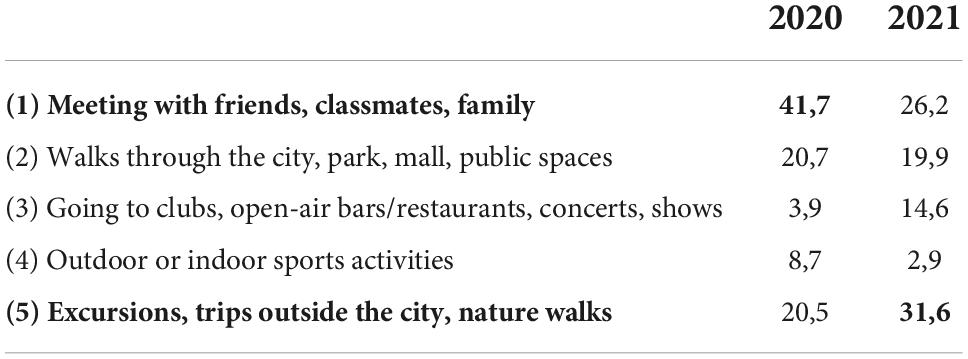
Table 2. Q3. What is the main thing that you had to give up because of social isolation and which you miss the most now?
Other differences showed up when students were asked about activities they were looking forward to in the post-restriction period (Q7). At the time of the first study, May 2020, there had just been two months of national lockdown and expectations were chiefly related to the very limited possibilities people had had to leave their homes. In the second study, in May 2021, students were thinking more about the frustration of their holiday plans due to the risk of infection. Table 3 presents the answers given to the following open question:
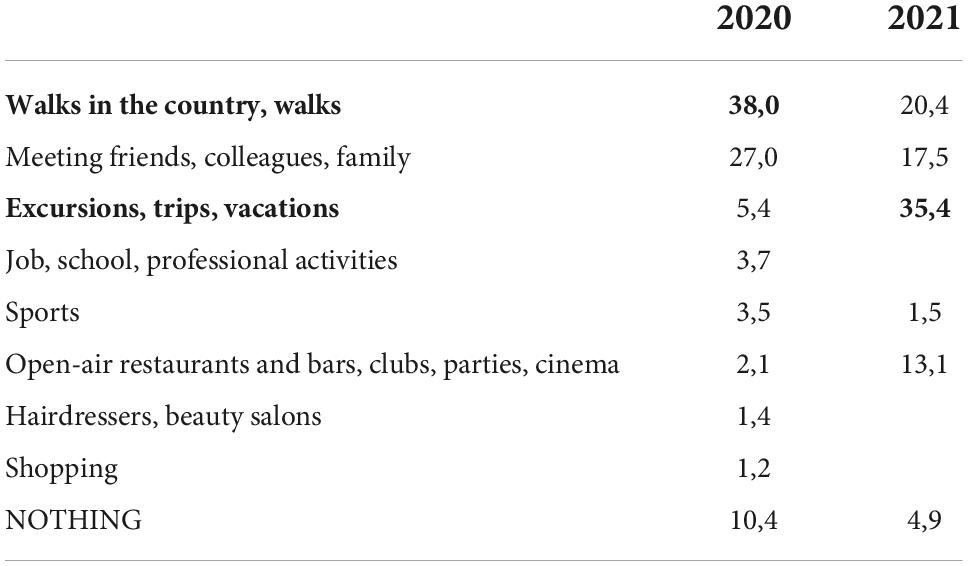
Table 3. Q7. What is the first thing you will do in the period after the lifting of all the restrictions imposed as a consequence of the pandemic?
As previously mentioned, not all questions were identical across the two surveys. There was one in 2020, after the two months of lockdown, about a different future approach, and one about major gains and losses after one year of pandemic in 2021. Answers to the 2020 question about a different approach to a future lockdown are presented in Table 4.
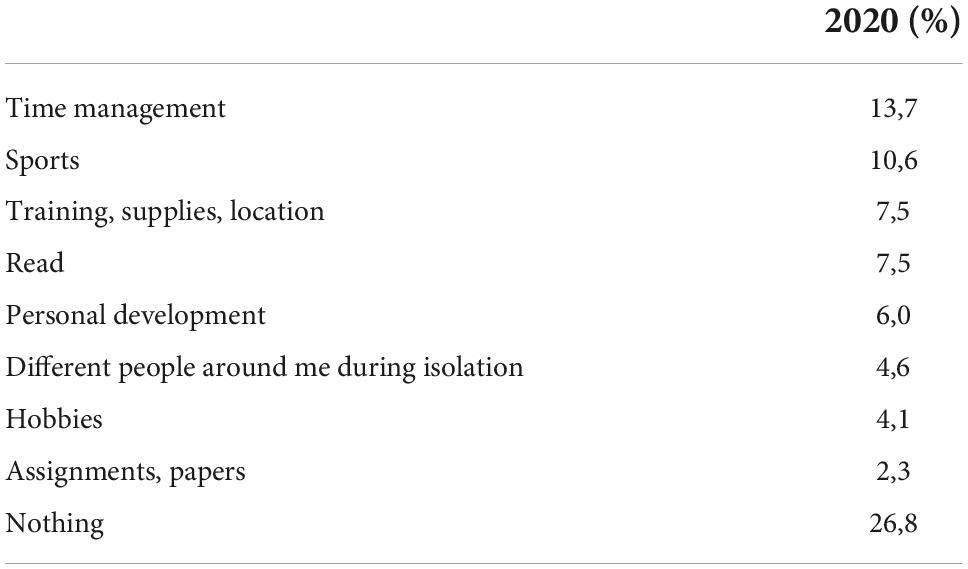
Table 4. Q9. If such a situation of strict social isolation were to be repeated, what would you do differently?
Looking at these free answers, it is clear that the main perceptions of failure/poor decisions after the two months of national lockdown (16 March to 15 May 2020) have to do with time management and physical activities. It was a very confused period, completely new for everyone and involving massive changes in lifestyle for students, with classes all happening online and no group activities, with very limited professional opportunities and other similar restrictions. Thus, adaptation to the new context took place in very unclear circumstances: no one knew what the duration of the restrictions would be, or how the COVID-19 pandemic would develop. Chaotic time management was a direct consequence of this. Also, staying at home all day for many days per week significantly reduced their physical activities, and replacing these with indoor workouts was not an easy step. In the 2021 survey this question was replaced with two new items about gains and losses after one year of the pandemic. The free answers to these are presented in Table 5.
To judge by these distributions, after one year of social distancing and online classes, the main achievement for students was an improvement in school results (examinations, projects, and dissertation papers) and the most serious loss was represented by the lack of socialization due to very limited opportunities to spend time together with classmates, friends or other young people. Another item (Q6) dealing with specific activities also showed up some differences among subjects. Figure 2 presents the weighted scores for each statement, with answers on a five-point Likert scale, from strongly disagree = 1 to strongly agree = 5:
Thus, for both samples, the chief focus of students during the pandemic period was on projects for school (72.7% agree or strongly agree in 2020, and 72.4% in 2021), while the least present activity was the daily workout (43.9% agree and strongly agree in 2020, and 37.1% in 2021). The main changes after one year of online teaching are seen in time spent on hobbies (from 46% agree or strongly agree in 2020, to 61% agree or strongly agree in 2021 or, as weighted scores, from 3.00 in 2020 to 3.62 in 2021), and in the feeling of boredom (from 48.2% agree or strongly agree in 2020 to 57.9% in 2021, respectively, from 3.16 in 2020 to 3.56 in 2021). Both of these are statistically significant: test t = 2.430, p = 0.015 for hobby time differences and test t = 3.433, p = 0.001 for feeling bored. Apart from these differences, the remainder of the statements show very similar values, suggesting quite stable behavior on the students’ part during the pandemic and possibly a quite high level of resilience, reflected in a constant daily agenda during a year of various social restrictions. An exploratory factor analysis carried out for these nine variables shows a quite strong association among them (KMO = 0.659) and generates two main factors (F1 and F2 in Table 6) that account for 40.736% of the total variance (Bartlett’s test of Sphericity χ2 = 570.316, df = 36, p < 0.001, Extraction Method: Maximum Likelihood Analysis. a. 2 components extracted, Rotation Method: Varimax with Kaiser Normalization, Rotation converged in 3 iterations):
As can be observed from the above table, there are two distinct factors that describe the way students dealt with the period of the pandemic:
- F1 is characterized by a lack of physical activity, withdrawal into TV, PC games, changes in sleeping routines, weight gain and boredom. Without any negative connotation being implied, this pattern of behavior can be termed that of the “badger student”. It almost resembles a dolce far niente lifestyle as a response to pandemic restrictions and to uncertainty about what the future would hold. This factor has a significant negative correlation with impact of social isolation on lifestyle Q1 (r = −0.279, sig < 0.01, N = 681) and with changes in lifestyle Q2 (r = −0.194, sig < 0.01, N = 682). We may draw an important conclusion from these data: those students who tend to adopt a badger profile (remaining mostly inactive and with a leisure-based lifestyle during the restrictions) are ones on whom social isolation had only a limited impact, since they already tended to be more introverted and inside-orientated. This is confirmed by the second significant correlation, the fact that students who adopted a badger approach did not make great changes in their previous lifestyle. This factor has also a significant positive correlation with perception of the passage of time (r = 0.146, sig < 0.01, N = 679) and with age (r = 0.205, sig < 0.01, N = 677). In other words, this type of students perceived time as passing more slowly than before, and they are older on average than the others.
- F2 describes an opposite approach, with daily workouts and a focus on academic projects, reading and hobbies. Such students can be described as “beaver students” because of their active lifestyle. This factor has a significant positive correlation with the impact of social isolation on lifestyle Q1 (r = 0.111, sig < 0.01, N = 681). In other words, for these students the pandemic context functioned as a spur to engage in activities and projects and to become more dynamic.
We next identified in the database the most representative subjects for each of these categories, on the basis of the cumulative answers to the statements of Q6: at least four answers of strongly agree to 5 of the items for the badger model for boredom, TV, computer games, sleep and weight (Nbadger = 111) and at least three answers of strongly agree for the beaver model for the items regarding hobbies, working out, reading, and academic study (Nbeaver = 152). Subjects that matched both categories were eliminated. Both the impact of the pandemic context (Q1) and changes in lifestyle (Q2) are significantly different when these two groups are compared: test t = 5.667, p < 0.001for pandemic impact, and test t = 2.609, p = 0.010 for changes in lifestyle due to pandemic conditions. The directions of influence are presented in Table 7.
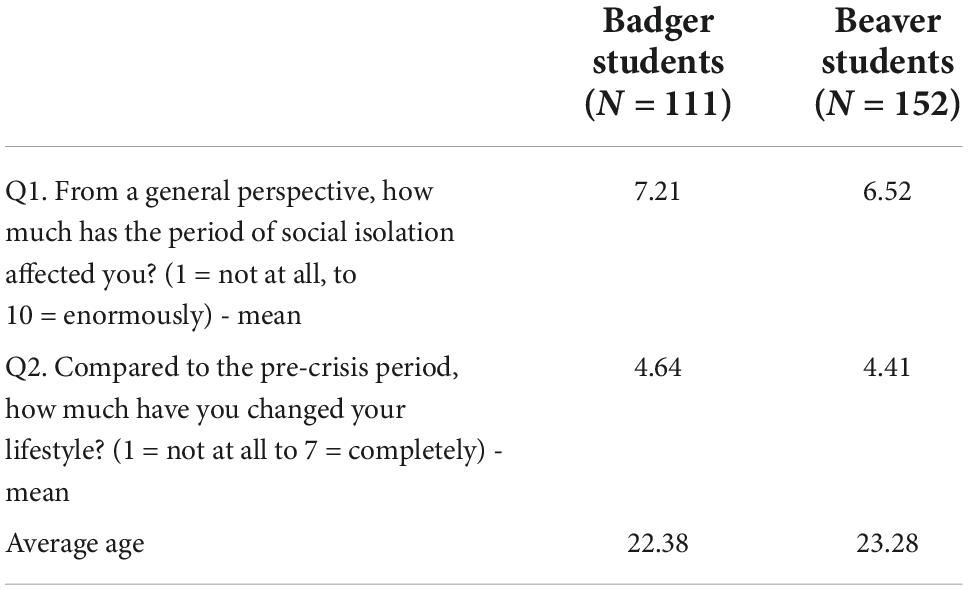
Table 7. Mean values for pandemic impact, changes in lifestyle, and age for badger and beaver students.
Discussion
On the basis of these two pieces of research, after one year of online teaching students showed a broadly similar behavior, without significant changes. They displayed quite a high degree of resilience in the context of this new lifestyle, but it was not clear how long they would be able to maintain the same pattern of life. The pandemic situation acted as a facilitator for home-loving and leisure-orientated students, who adopted what we have called the badger model of adapting to social restrictions. Students of this kind took refuge in an entertainment universe accessible from home, based on digital platforms (movies, games, social media).
Badger students simply wait for the pandemic to end so that they can return to their previous normality. If this does not happen soon, we may predict that it will be quite difficult for them to adapt back from their current daily agenda. In contrast with this approach, the pandemic context also acted as a motivating factor and encouraged other students to react in a proactive way and to find new opportunities to exploit the amount of available time as usefully as possible. We called this the beaver model. It represents a more resilient approach from which feelings of wasting time or bad time management are almost completely absent. For beaver students, the pandemic context brought new opportunities for professional and personal development, and they exploited these resources. They have every chance of being able to keep pursuing this lifestyle even after one or two years of pandemic restrictions, if that happens, especially since their academic efforts have clearly brought results.
As limits of the studies carried out, we mention the use of availability samples that do not allow an extrapolation of the results, the lack of control of the subjects, the application online without a clear report to the basic population or to a unitary selection procedure. There were also a series of limitations generated by the online application, namely the use of a shorter questionnaire accessible only to students with Internet access and present on professional social-media groups. In addition, we also mention the lack of a complementary qualitative approach to detail why they have become badgers or beavers, but this could be the research question for a future study.
Conclusion
Looking back, over two and a half years after the beginning of the COVID-19 pandemic, everything looks like a nightmare. Fear, risk, uncertainty, loss of known people, restrictions, and longing for a way out. Of all the radical changes we went through back then, the shift to online school was, probably, one of the easiest challenges. Of course, not everywhere and, especially, not without major consequences. For some, it was almost like a sabbatical period; for others, it was a period full of opportunities.
The online teaching methods imposed during the pandemic have acted as a facilitator of two opposite student styles: growth-promoting and regressive. Students already well orientated toward personal and professional development were able to use this time to increase their achievements. We see them using the increase in individual control over time management and personal agenda to engage in a variety of professional and personal activities, to gain better grades, to take part in voluntary projects and to keep healthy via outdoor activities and workouts. They are “beaver” students and their resilience in the pandemic context is in fact based on their sustainable approach to coping with stressors. In contrast with this style, students who were already orientated toward leisure and a relaxed approach to life were also helped by the pandemic context to continue in this direction. With an excess of TV, PC games, social media, irregular sleeping patterns and a lack of physical activity, they tend to adopt the “badger” model. Of course, this is not a sustainable one, and associated health problems began to appear. A major challenge for university teachers, after three semesters of online education, is to identify students who tend to be badgers and to encourage them to make changes to their lifestyles.
Data availability statement
The datasets presented in this study can be found in online repositories. The names of the repository/repositories and accession number(s) can be found below: https://doi.org/10.3886/E156721V1.
Ethics statement
The studies involving human participants were reviewed and approved by Ethics Committee of the West University of Timişoara (no. 55251/0-1/2020). Written informed consent for participation was not required for this study in accordance with the national legislation and the institutional requirements.
Author contributions
BN: conception, methods, investigation, data analysis and interpretation, and writing original draft. MP: data analysis, editing, review, and final version. Both authors contributed to the article and approved the submitted version.
Funding
The publishing of this article was supported by West University of Timişoara, Romania.
Conflict of interest
The authors declare that the research was conducted in the absence of any commercial or financial relationships that could be construed as a potential conflict of interest.
Publisher’s note
All claims expressed in this article are solely those of the authors and do not necessarily represent those of their affiliated organizations, or those of the publisher, the editors and the reviewers. Any product that may be evaluated in this article, or claim that may be made by its manufacturer, is not guaranteed or endorsed by the publisher.
References
Ali, W. (2020). Online and remote learning in higher education institutes: A necessity in light of Covid-19 pandemic. High. Educ. Stud. 10, 16–25. doi: 10.5539/hes.v10n3p16
Araújo, F. J. O., de Lima, L. S. A., Cidade, P. I. M., Nobre, C. B., and Neto, M. L. R. (2020). Impact of sars-Cov-2 and its reverberation in global higher education and mental health. Psychiatry Res. 288:112977. doi: 10.1016/j.psychres.2020.112977
Babicka-Wirkus, A., Wirkus, L., Stasiak, K., and Kozłowski, P. (2021). University students’ strategies of coping with stress during the coronavirus pandemic: Data from Poland. PLoS One 16:e0255041. doi: 10.1371/journal.pone.0255041
Bolumole, M. (2020). Student life in the age of Covid-19. High. Educ. Res. Dev. 39, 1357–1361. doi: 10.1080/07294360.2020.1825345
Bran, R. A., and Grosseck, G. (2020). Press RESET: Digitalising education in disruptive times. Rev. Rom. Pentru Educ. Multidimens. 12(1Suppl. 2) 39–48. doi: 10.18662/rrem/12.1sup2/245
Browning, M., Larson, L. R., Sharaievska, I., Rigolon, A., McAnirlin, O., Mullenbach, L., et al. (2021). Psychological impacts from Covid-19 among university students: Risk factors across seven states in the United States. PLoS One 16:e0245327. doi: 10.1371/journal.pone.0245327
Burgess, S., and Sievertsen, H. H. (2020). Schools, skills, and learning: The impact of Covid-19 on education. London: CEPR.
Cairns, D. França, T., Calvo, D. M., and Azevedo, L. F. (2021). Immobility, Q18 precarity and the Covid-19 pandemic: The impact of lockdown on international students in Portugal. J. Youth Stud. 25, 1–15. doi: 10.1080/13676261.2021.1948981
Coman, C., Ţîru, L. G., Meseşan-Schmitz, L., Stanciu, C., and Bularca, M. C. (2020). Online teaching and learning in higher education during the coronavirus pandemic: Students’ perspective. Sustainability 12:10367. doi: 10.3390/su122410367
Dhawan, S. (2020). Online learning: A panacea in the time of Covid-19 crisis. J. Educ. Technol. Syst. 49, 5–22. doi: 10.1177/0047239520934018
Di Pietro, G., Biagi, F., Costa, P., Karpiński, Z., and Mazza, J. (2020). The likely impact of Covid-19 on education: Reflections based on the existing literature and recent international datasets. Luxembourg: Publications Office of the European Union.
Elmer, T., Mepham, K., and Stadtfeld, C. (2020). Students under lockdown: Comparisons of students’ social networks and mental health before and during the Covid-19 crisis in Switzerland. PLoS One 15:e0236337. doi: 10.1371/journal.pone.0236337
Gherheş, V., şimon, S., and Para, I. (2021). Analysing students’ reasons for keeping their webcams on or off during online classes. Sustainability 13:3203. doi: 10.3390/su13063203
Goncalves, A., Le Vigouroux, S., and Charbonnier, E. (2021). University students’ lifestyle behaviors during the Covid-19 Pandemic: A four-wave longitudinal survey. Int. J. Environ. Res. Public Health 18:8998. doi: 10.3390/ijerph18178998
Gonçalves, S. P., Sousa, M. J., and Pereira, F. S. (2020). Distance learning perceptions from higher education students—the case of Portugal. Educ. Sci. 10:374. doi: 10.3390/educsci10120374
Khan, M. A., Vivek, Nabi, M. K., Khojah, M., and Tahir, M. (2021). Students’ perception towards E-learning during Covid-19 pandemic in India: An empirical study. Sustainability 13:57. doi: 10.3390/su13010057
Machado, D. B., Alves, F., Teixeira, C., Rocha, A., Castro-de-Araujo, L., Singh, A., et al. (2020). Effects of Covid-19 on anxiety, depression and other mental health issues: A worldwide scope review. Res. Sq. [Preprint]. doi: 10.21203/rs.3.rs-58186/v1
Marek, M. W., Chiou, S. C., and Wen-Chi Vivian, W (2021). Teacher experiences in converting classes to distance learning in the Covid-19 pandemic. Int. J. Distance Educ. Technol. 19, 89–109. doi: 10.4018/IJDET.20210101.oa3
Marinoni, G., Van’t Land, H., and Jensen, T. (2020). The impact of Covid-19 on higher education around the world. IAU global survey report. Paris: International Association of Universities.
Mishra, L., Gupta, T., and Shree, A. (2020). Online teaching-learning in higher education during lockdown period of Covid-19 pandemic. Int. J. Educ. Res. Open 1:100012. doi: 10.1016/j.ijedro.2020.100012
Obrad, C. (2020). Constraints and consequences of online teaching. Sustainability 12:6982. doi: 10.3390/su12176982
Popa, D., Repanovici, A., Lupu, D., Norel, M., and Coman, C. (2020). Using mixed methods to understand teaching and learning in Covid 19 times. Sustainability 12:8726. doi: 10.3390/su12208726
Schleicher, A. (2020). The impact of Covid-19 on education insights from education at a glance 2020. Paris: OECD.
School Education Gateway (2020). Survey on online and distance learning—results. Available online at: https://www.schooleducationgateway.eu/en/pub/viewpoints/surveys/survey-on-online-teaching.htm (accessed September 24, 2021).
Sobaih, A. E. E., Hasanein, A. M., and Abu Elnasr, A. E. (2020). Responses to Covid-19 in higher education: Social media usage for sustaining formal academic communication in developing countries. Sustainability 12:6520. doi: 10.3390/su12166520
Son, C., Hegde, S., Smith, A., Wang, X., and Sasangohar, F. (2020). Effects of Covid-19 on college students’ mental health in the United States: Interview survey study. J. Med. Internet Res. 22:e21279. doi: 10.2196/21279
Stevanovic, A., Bozic, R., and Radovic, S. (2021). Higher education students’ experience and opinion about distance learning during the Covid-19 pandemic. J. Comput. Assist. Learn. 37, 1682–1693. doi: 10.1111/jcal.12613
Teixeira, R. J. Brandão, T., and Dores, A. R. (2021). Academic stress, coping, emotion regulation, affect and psychosomatic symptoms in higher education. Curr. Psychol. 41, 1–10. doi: 10.1007/s12144-020-01304-z
Trzebiński, J., Cabański, M., and Czarnecka, J. Z. (2020). Reaction to the Covid-19 pandemic: The influence of meaning in life, life satisfaction, and assumptions on world orderliness and positivity. J. Loss Trauma 25, 544–557. doi: 10.1080/15325024.2020.1765098
Keywords: student life quality, COVID-19, online learning, daily routine, sociological survey
Citation: Nadolu B and Petrescu M (2022) Badger vs. beaver patterns in Romanian student life during the pandemic. A two-wave longitudinal approach. Front. Educ. 7:982394. doi: 10.3389/feduc.2022.982394
Received: 30 June 2022; Accepted: 13 October 2022;
Published: 28 October 2022.
Edited by:
Chien-liang Lin, Ningbo University, ChinaReviewed by:
Lucian Lupu-Dima, Universitatea din Petroşani, RomaniaJosue Gutierrez-Barroso, University of La Laguna, Spain
Copyright © 2022 Nadolu and Petrescu. This is an open-access article distributed under the terms of the Creative Commons Attribution License (CC BY). The use, distribution or reproduction in other forums is permitted, provided the original author(s) and the copyright owner(s) are credited and that the original publication in this journal is cited, in accordance with accepted academic practice. No use, distribution or reproduction is permitted which does not comply with these terms.
*Correspondence: Bogdan Nadolu, Ym9nZGFuLm5hZG9sdUBlLXV2dC5ybw==
 Bogdan Nadolu
Bogdan Nadolu Magdalena Petrescu
Magdalena Petrescu